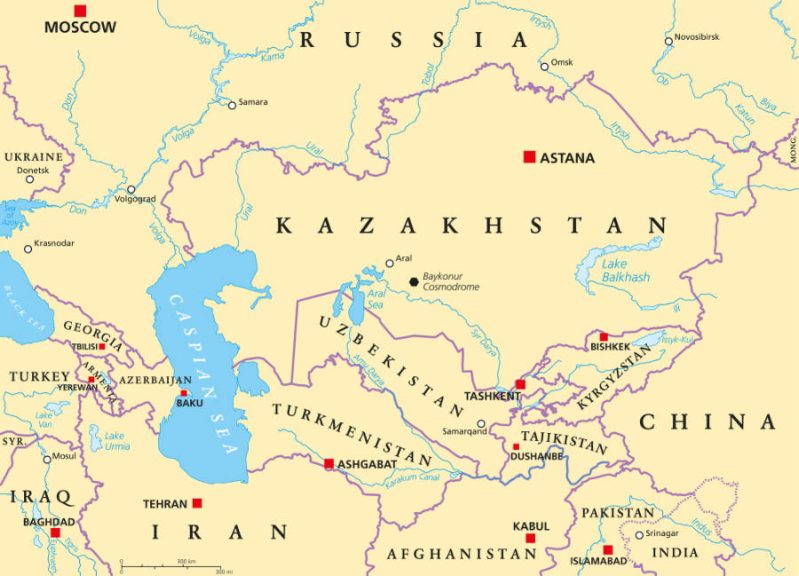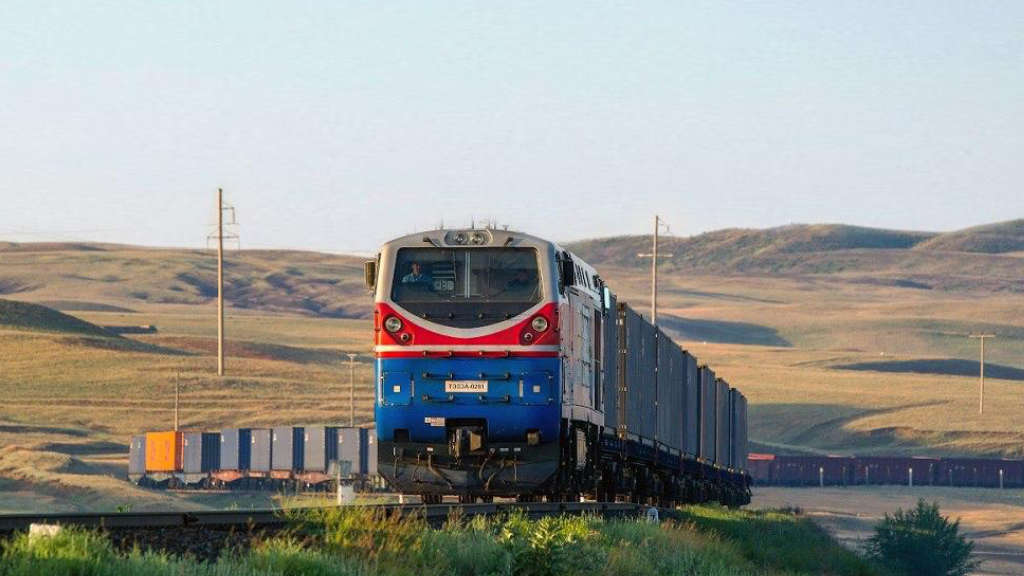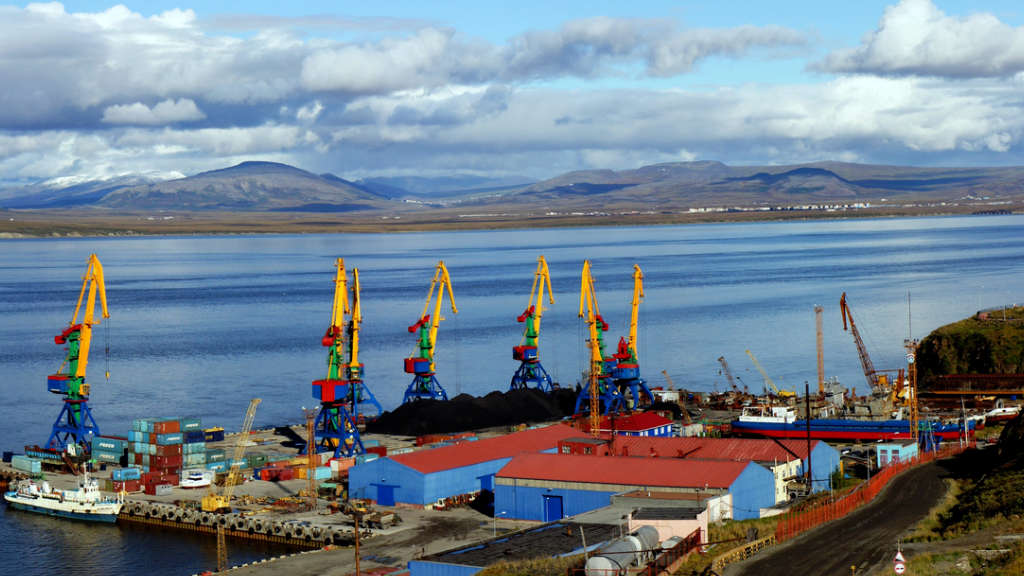During his speech at the Central Asia-Russia Summit in Dushanbe last week, Kazakh President Kassym-Jomart Tokayev highlighted the strengthening of transport and logistics ties with Russia as a priority area of cooperation.
Tokayev said “For Kazakhstan, cooperation with Russia is strategically vital. In view of the geographic factor, Kazakhstan can ensure a stable connection between East and West, North and South, serving as the central link in the Eurasian transport and logistics network. Russia, in turn, is a key gateway for regional countries to global markets. Therefore, cooperation with Russia in transport and logistics is of paramount strategic importance. 11 international transport corridors pass through Kazakhstan (including 5 rail and 6 road), handling approximately 85% of overland freight traffic between Asia and Europe. Over the past 15 years, over $35 billion has been invested in the comprehensive modernization of the industry. As a result, we have achieved sustained growth in transportation volumes. Rail freight transit from Russia to Central Asia via Kazakhstan has risen by 26% over the past three years, exceeding 30 million tons. Meanwhile, transit in the opposite direction has increased by almost 50%. Shipments from Russia to China via Kazakhstan have tripled, reaching over 5 million tons.”
Earlier, Tokayev said that Kazakh trade with Russia had reached US$28 billion in 2024.

Central Asian Connectivity
Central Asia is a vast region that stretches from the Caspian Sea in the west to Xinjiang, China in the east, Afghanistan in the south, and Russia in the north. After the disintegration of the Soviet Union, Central Asia became the five independent republics of Kazakhstan, Kyrgyzstan, Tajikistan, Turkmenistan, and Uzbekistan. These countries have a combined population of over 74 million people. However, they retain their Soviet-era railway connectivity to Russia, with these now being upgraded and expanded. They have also – and are continuing – to expand eastwards with further connectivity to China. This opens up significant additional routes from Russia through to the Chinese network, as we explain as follows:
Kazakhstan

Kazakhstan is surrounded by five Central Asian countries and Russia, and although it has an eastern Caspian Sea coastline, it has limited external traffic to international TIR vehicles, although its Caspian Ports are being developed. However, the volume of highway automobile transportation is small, and costs are relatively high.
Accordingly, Kazakhstan has developed railway lines that connect to China, Moscow, and many European countries, as well as neighbouring Turkmenistan, Kyrgyzstan, Uzbekistan, and Tajikistan. It also extends east to Afghanistan and Iran. In terms of land area, Kazakhstan is the largest in Central Asia, with its GDP also ahead of its most of its neighbours.
To efficiently transport a large number of goods from China to Kazakhstan, strong logistics support is essential. Before the opening of the “Central Asia trains” China-Kazakhstan container railway transportation, goods were primarily transported through multimodal methods such as international automobile transportation. This involved using Chinese logistics to transport the goods from the far south to Alashankou, in China’s Xinjiang region, for customs declaration and export.
The opening of the international train container line between China and Kazakhstan has effectively resolved the logistical challenges between the two countries and has significantly boosted the rapid development of their economies, although further expansion will be necessary.
There are only two railway stations along the route from China to Kazakhstan that offer international container railway transportation throughput services. These are Xi’an in Shaanxi and Qingdao in Shandong Province. From these, container transport to Kazakhstan is divided into multiple routes and departure trains. In total, there are over 17 railway routes running to Almaty, Astana, Trau, Karaganda, and Zimkent.
The container railway transportation route from China to Kazakhstan can be summarized by its four main routes:
- China West – Chengdu-Almaty
Linking Chengdu, Chongqing, Yiwu, Shenzhen, Guangzhou, Dongguan, Huizhou, Shanghai, Beijing, Xi’an, Wuhan, Changsha, Xiamen, and Alashankou, to Atenkoli and Almaty.
- China North – Shantou-Astana
Linking Shantou, Heyuan, Suzhou, Tianjin, Guangxi and Alashankou to Dostyk and Astana
- China East – Qingdao-Astana
Linking Qingdao, Tianjin, Shenyang, Yantai, Laiyang, Weifang, Zibo, Jinan, Dezhou, and Linyi to Almaty and Astana.
- China South – Zhongshan-Zimkent
Linking Zhongshan, Foshan, Jiangmen, and Horgos to Atenkori and Zimkent.
There are a total of 17 container railway transportation routes from China to Kazakhstan. Some of these routes overlap, with one or two trains being issued per week for each route. The running time for these routes is calculated from the start of the train, including the time for intermediate track changes, and the total railway time to reach the destination port is 15-20 days.
Kazakhstan’s Almaty, Astana and Zimkent railway stations are connected to Russia via the double-tracked Trans-Aral route which further connects to the main Russian railway network at Rostov-On-Don. This route extends for 9,200km.
Compared with the Belt and Road Central Europe Express, the Central Asia-Kazakhstan railway has a slower running time, with the travel distance from China to Kazakhstan being over 3,000 kilometers. The main reason for this longer travel time is the cost of the changing rail gauges, which only takes place at midday. The Kazakh-Russia gauges are the same dimensions and do not require changing.
Kyrgyzstan

Kyrgyzstan is a landlocked country in the northeastern part of Central Asia. It shares borders with Kazakhstan to the north, Uzbekistan to the west, and Tajikistan to the south, and meets China to the southeast and east. With a total land area of 199,000 Km2 and a population of about 6 million, Kyrgyzstan is an important link connecting Eurasia and the Middle East and has historically been a key transit point for neighbouring countries’ forces traveling east and west, as well as south and north. The main cities in Kyrgyzstan include Chuhe, Taras, Osh, Jalalabad, Naryn, Issyk-Kul, Batken, Bishkek, and Osh.
Kyrgyzstan’s railway network spans over 500 kilometers and is divided into two parts, with the rail width adhering to the Russian standard. The railway transportation in the country is still underdeveloped, but it plays a crucial role in the multimodal transport system. It connects to the Kazakhstan railway network in the west and has a southern railway that extends 101.2 kilometers and connects to Xinjiang, China. Kyrgyzstan sees a significant number of trains from the China-Europe Express on the Belt and Road, making it a key player in the “New Silk Road”.
China is Kyrgyzstan’s second-largest trading partner after Russia, and a significant amount of cargo transportation between the two countries relies on railway transportation. This method is not only the lowest cost, but also the most stable form of international multimodal transportation. In addition to railway transportation, there are also options for international TIR transportation and international air transportation to Kyrgyzstan.
Specifically, the railway transportation routes from China to Kyrgyzstan include the route from Guangzhou to Chengdu to Alashankou to Alamejin. Guangzhou serves as a transit warehouse for consolidation, where goods from provinces and regions such as Hong Kong, Shenzhen, Dongguan, Foshan, Huizhou, and Shantou are transported and then collectively sent to Chengdu Railway Station in Sichuan. This is an important starting point for the China-Europe train, providing rail transportation not only to Europe, but also container international rail transportation to the five countries of Central Asia and Russia.
The railway transportation route from China to Kyrgyzstan spans over 7,000 kilometers and typically takes around 20 to 21 days for goods to be transported. Railway connections from Russia to Kyrgyzstan (which do not share a border) are via Kazakhstan and Uzbekistan with connections from either Taraz and Tashkent through to Bishkek.
Tajikistan

Tajikistan has the smallest land area among the Central Asian countries. It is landlocked, covering an area of 143,100 Km2. It borders Uzbekistan and Kyrgyzstan to the west, China’s Xinjiang to the east, and Afghanistan to the south. The terrain is mostly mountainous, with 90% of the land consisting of mountains and plateaus, with about half of them being 3,000 meters above sea level.
The railway transport routes from China to Tajikistan include major cities in China, with the option for self-prepared box SOC/rental box COC/car skin to be transported to the main station in Tajikistan through Alashankou or Dostyk. Rail connections to Russia run from Volgograd to Dushanbe with discussions currently underway about expanding these.
Turkmenistan

Turkmenistan is situated north of Iran and shares borders with Afghanistan to the southeast, Uzbekistan to the northeast, Kazakhstan to the northwest, and the Caspian Sea to the west. It covers an area of 491,200 Km2, making it the second-largest Central Asian country after Kazakhstan.
The route consists of major cities in China with self-prepared SOC/rental COC, all rail or sea rail, leading to Alashankou/Dostyk and main stations in Turkmenistan.
Most Russia – Turkmenistan rail freight transits via ship at Turkemenistan’s Caspian Sea port at Turkmenbashi, and from there onto Turkmenistan’s rail network, although there is also rail connectivity via Kazakhstan.
Uzbekistan

The railway freight transportation from China to Uzbekistan plays a crucial role in promoting economic interoperability and development between the two countries. This international railway freight logistics initiative was established in September 2013, following President Xi Jinping’s “Silk Road Economic Belt” initiative. This initiative has opened up opportunities for economic cooperation between China and Uzbekistan. It is essential to invest in logistics infrastructure for economic development, as smooth goods circulation, low logistics costs, and short transportation times are crucial for supporting economic growth. The international multimodal railway route connecting cities in Uzbekistan to various cities in China is the result of collaborative efforts between the governments of both countries.
The China-Uzbekistan railway line begins at the “China-Europe Express” Xi’an Station. Goods can be received simultaneously in multiple locations across China, such as Dongguan, Zhongshan, Qingyuan, Dalian, Beijing, and Zhengzhou. Our international transshipment warehouses in these areas facilitate transport to the departure railway station in Xi’an, from where goods are transported onward to Uzbekistan.
China to Uzbekistan railway operations run Xi’an – Khorgos – Atenkori – Tashkent, with the route from China to Uzbekistan spans over 8,000 kilometers and requiring more than 15 days for the entire transportation process, including transit through the country, changing rail tracks, and switching railway companies.
Of additional note is the China-Kyrgyzstan-Uzbekistan (CKU) railway which is currently under construction and which should be operational by 2030. That runs from Kashgar – Irkeshtam – Osh – Andizhan-Tashkent.
Russia is connected to Uzbekistan by rail via the Trans-Caspian railway, which terminates at Turkmenistan’s Turkmenbashi port and continues via rail ferry to Astrakhan, with a second option being the Turkestan-Siberia Railway to Novosibirsk via Arys in Kazakhstan.
Further Reading
Kazakhstan Rail Transit Via Russia & The INSTC Increases By 63% In Q1 2025





